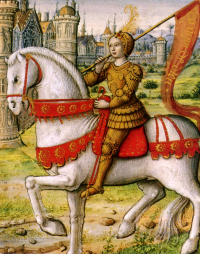
St Joan of Arc (1413-1431)
Feast day: 30 May
St Joan of Arc came from the village of Domremy in the area of Lorraine, in north-eastern France. She was born in 1413, the daughter of a tenant farmer. Her mother was very pious and Joan followed her example. At this time France was torn by civil strife between the Armagnacs, supporters of the crown, and the Burgundians who were ruled by a powerful duke and allied with the English. The king of France, Charles VI, was insane, and after the battle of Agincourt in 1415 the English King Henry V married Catherine, his daughter and by the Treaty of Troyes 1420 it was agreed that Henry and his heirs would inherit the crown of France when Charles VI died. The dauphin, the rightful heir to the throne, was thus disinherited by his own mother, who was party to the agreement. Much of France was then occupied by the English and Burgundians, including the city of Rheims where the Kings of France were traditionally crowned.
When she was about thirteen, Joan began to hear the voices of certain saints, namely Michael the Archangel, St Margaret and St Catherine, who were venerated in her local church. They instructed her to go to the dauphin and support him in driving the English from France. The voices became so insistent that Joan with great difficulty managed to obtain access to the dauphin at his court in Bourges. She wore male attire as a protection. Charles tried to hide among his courtiers but she singled him out. She was given an army and successfully raised the siege of Orleans. After other victories she was finally able to see the dauphin crowned at Rheims as Charles VII.
Joan had hoped that she might be allowed to go back to her village of Domremy but it was not to be. She took part in further battles including an attempt to take Paris, and was eventually captured at Compiegne by the Burgundians, who handed her over to their allies the English. Since they could not convict her of fighting against them she was passed over to the church authorities. The pro-English bishop of Beauvais, Pierre Cauchon, led the proceedings. The trial of the nineteen-year-old illiterate peasant girl was a travesty of justice on many counts, for the English were determined to get rid of her. The right to appeal to the Pope was denied her. The many charges against her, including witchcraft and heresy, were eventually whittled down and the main accusations were wearing male clothing and claiming that she was acting on divine orders. She was persuaded to sign a document denying any divine involvement and agreeing to wear female dress. However she soon recanted and put on her male attire again. She was condemned to death by Cauchon and burnt at the stake in the market place of Rouen in 1431.
Twenty years later Charles VII ordered an investigation, and Pope Calixtus III exonerated Joan. She was canonized in 1920 and her equestrian statue stands proudly beside that of St Louis IX, King of France, overlooking the city of Paris at Sacre Coeur. Her story has become an inspiration for artists, writers, dramatists and soldiers. Charles VII went on to become one of France’s more effective rulers and by 1453 the English had been virtually driven out of France, their sole remaining possession being Calais.
St Joan of Arc, pray for us.